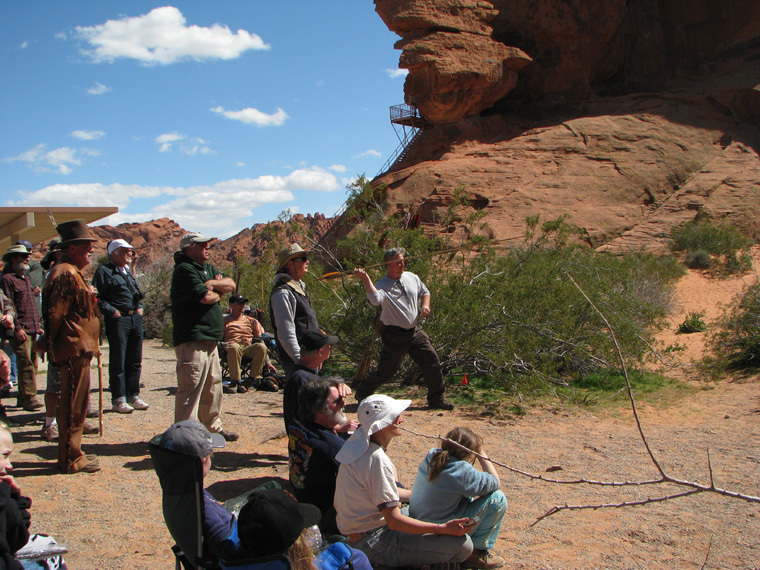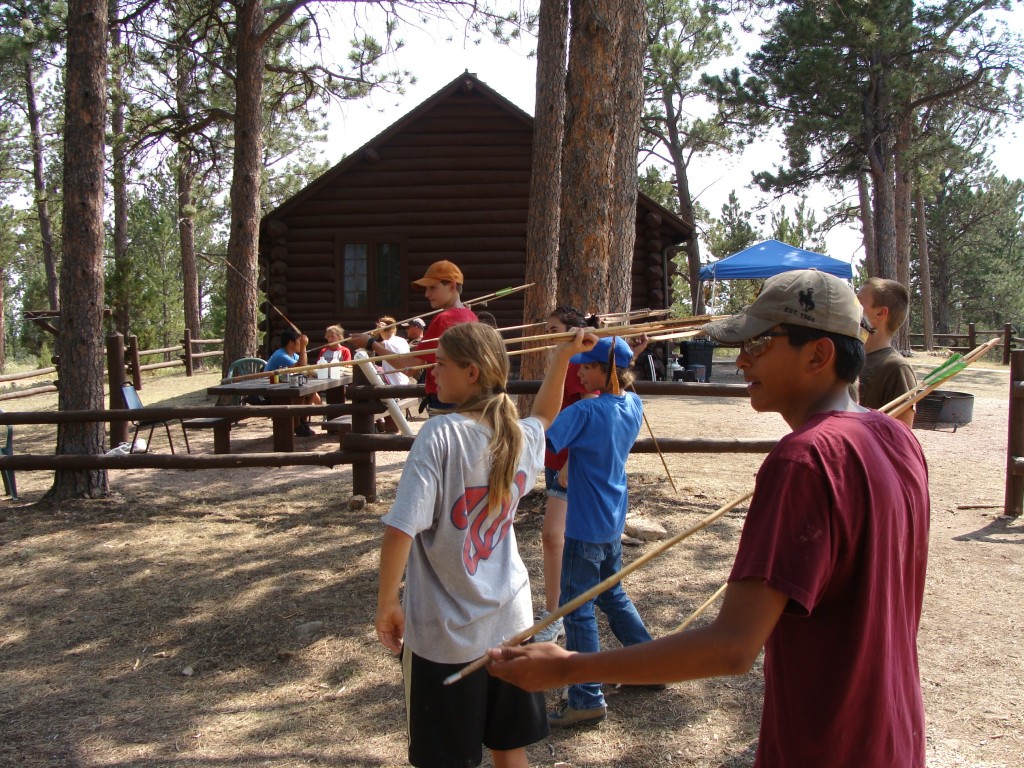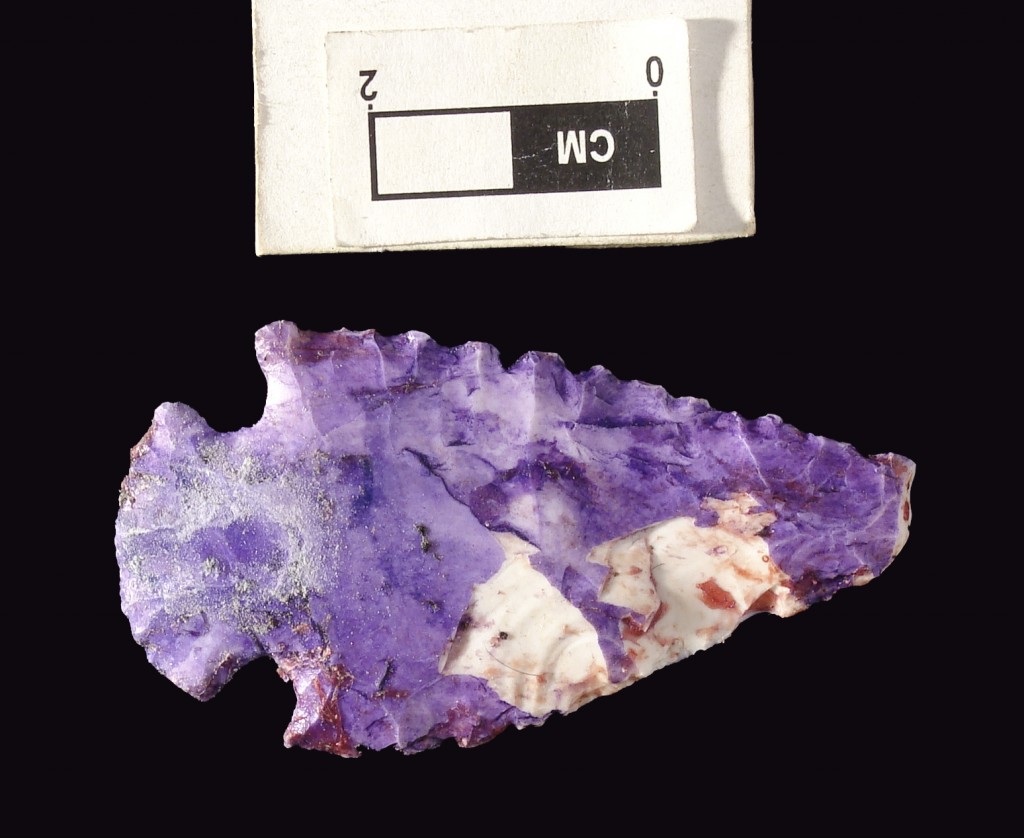Devin Pettigrew
6/30/2013
Contemporary atlatlists can provide important contributions to our understanding of the human past. Experience has shown that the atlatl and dart is a valuable tool for education through a direct hands-on approach. Using ancient technology is exciting and interesting for contemporary folks. It both grabs the attention and informs. For research, experimentation with the atlatl and dart can be carried out by both specialists and enthusiasts. Special consideration will be given to the reproduction of ancient atlatl gear. This short article will cover both educational and research aspects, thus providing, I hope, some inspiration and direction for educators and researchers of all types who would like to employ atlatls in their pursuits.
Education
In recent years I have regularly attended WAA (World Atlatl Association) events at two important archaeological sites. Each fall an event is held at Cahokia Mounds State Historic Site in Illinois, and each spring I make a pilgrimage to the Valley of Fire State Park in Nevada (Figure 1). Although Cahokia, the largest prehistoric urban center in North America, was occupied during bow and arrow times, the atlatl and dart may have had a presence there during its heyday; either as an ancestral or religious symbol or to fill a certain functional niche. For instance, in Mesoamerican societies the atlatl carried on in warfare and hunting aquatic birds, but was also linked to certain deities. In any case, the atlatl is valuable today as a tangible symbol of North American prehistory, which is the primary subject at the park. The Valley of Fire is known for its incredible prehistoric rock art. An important stop-off for visitors is “Atlatl Rock”, named for a naturalistic depiction of a Basketmaker type atlatl and dart pecked into the red sandstone, which forms the banner image for this website. An annual atlatl event takes place around the base of the rock.

Figure 1. Visitors and attendants watch former WAA president Tom Mills launch a dart at the Valley of Fire. Steps to Atlatl Rock can be seen in the background. Photo by Mark Dell.
These events serve the interests of both park and atlatlists. The atlatlists get to hold an event at an important location that embodies some aspect of the human past, often a context of ancient atlatl use. In turn the park may see an increase in visitor interest and activity. At all times safety must be a precaution at these events. The atlatl and dart is a weapon, and must be respected as such. Such steps are taken at Cahokia and Valley of Fire by setting up fencing or caution tape around target ranges, and keeping park staff around to provide a watchful eye.
Atlatlists at these events often take the opportunity to connect with people about their interest, setting up display booths and providing equipment and instruction on throwing. Recently The Valley of Fire has acquired atlatl equipment and park staff has been trained in its use and history to help fill this niche. These events always draw a crowd of interested visitors, many of whom are eager to participate. Those interested in setting up an event can contact a member of the WAA through its website (http://waa.basketmakeratlatl.com/?page_id=189).
I have also used the atlatl as a tool in more direct educational contexts. I was personally brought into archaeology when my father taught our Boy Scout troop Indian Lore. He showed us a small pamphlet on the atlatl and sling, and I later tried my hand at recreating the weapons. Since then I have taught the same Scout troop Indian Lore with atlatls and other ancient technologies as an interactive medium. In many other cases I have presented the past to kids and adults through interactive tools such as the atlatl. Both groups, but especially kids seem to glaze over very quickly during my discussion of prehistory, though when presented with the atlatl and dart they are instantly enthralled, and many want to try their hand (Figure 2). If seeing it in action is fascinating, actually trying to throw provides the hook.
The act of using an atlatl is educational in that the user is provided a very personal feel for the past that in some ways may be similar to the experiences of ancient hunters; though it must be made explicit that we are not truly recreating ancient perspectives. Rather using an atlatl provides a tangible ‘glimpse’ of human life long ago—the feeling of a personal connection with our ancestors. This experiential learning can leave a mark on one’s psyche that will later encourage him/her to further pursue an interest in the past and in archaeology, further learning and hopefully teaching others the importance of our cultural heritage. Additionally people in contemporary societies are often fascinated with technology, and seeing the effective employment of an atlatl by someone who knows how to use it can create a cognitive dissonance—a notion that challenges one’s perspective. This is one of the most effective ways to learn (Merriman 2004:134). In this case the far too common and too long held belief that ancient people were rough, rude and “primitive” is replaced by an understanding that past peoples could be just as clever and skillful as people are today, despite that the technological foundation of their lives was not as complex.

Figure 2. After an afternoon of atlatl fun as part of my archaeology talk at a science camp in the Blackhills, these kids had to be dragged away to eat supper!
Aside from atlatl events or staff trained in hands-on teaching, the above effect can be met through a number of other mediums. I have met many individuals who have become interested through TV programs or movies in which the atlatl and dart are depicted, though to the trained eye the majority of these are fairly lacking in accuracy. Unfortunately the same can be said of many museum displays. Atlatl reproductions in museums are often crude, and do not give a visual feel for the intricacy and effectiveness of the original. Frison has put out a good argument against the very common and misguided depictions of poorly clothed Paleo-Indian hunters desperately trying to kill an angry mammoth in a bog with crude spears and rocks (2004). In reality the extremely skillful execution of their stone tools likely speaks for the rest of their equipment, and it may be more misleading to the viewer that the current depictions have left out or simplified what we don’t have exact details on; such as the likely complexity of Paleo-Indian clothing. Effective displays involve good descriptions and images, or better yet skillfully executed reconstructions of atlatl and dart gear. The Henderson Wetlands Nature Preserve in Nevada has recently installed such a display that includes a video showing the atlatl and dart in use (Chris Henry, personal communication 2013). When properly executed, a display of the atlatl and dart, an ancient technology that captures the imagination of contemporary people, can prove to be a powerful visual stimulus.
Basic goals for the educator:
- Develop an understanding of the cultures and histories associated with the atlatl and its context of use in your local area and other relevant regions
- Make or acquire examples of the technology that effectively demonstrate its intricacy and skill of craftsmanship for display or hands-on activities
- Develop familiarity and skill in crafting and/or using the technology; acquire good equipment and watch videos on throwing techniques, then practice!
Research
Learning the skillful use of the atlatl can provide all parties, including professional archaeologists, with important insights into the past. The experiences of enthusiasts (part-time specialists) have provided important contributions to the professional field as well (Coles 1979:; Whittaker 2012).
All manner of research can benefit through the application of proper procedures. Attempts should be made to study and build on past research, and to approach research with empirical goals in mind and an understanding of the necessary methods to record observations. Also, all parties would benefit from good communication about the results (see Whittaker 2012). Fulfilling these needs in regards to the atlatl and dart is one of the primary goals of our website. Comments sections and contact information help create an interactive connection with readers.
The atlatl can be used, with caution about the solidity of the insights, to provide experiential notions of ancient hunting and warfare practices. For instance, what is the typical effective range of the weapon in a hunting scenario? Can it be used with similar tactics later in use by hunters wielding bows and arrows? In combination with some early ethnographic records of indigenous atlatl use, the experiences of modern atlatlists can suggest answers to these and other questions, though it must be remembered that these answers are highly dependent on user skill and familiarity, hunting environment, and the characteristics of prey animals. Many of these things have changed drastically since ancient times.
Developing familiarity and skill with the tools under investigation is of utmost importance. In this area the atlatl as a modern sport is of greatest relevance to research. The atlatl’s effectiveness, being an extension of one’s self, is implicitly connected to the mental status of the thrower (see Pettigrew 2012). As stated we cannot reconstruct the exact mental status of ancient individuals, especially not under current circumstances where we throw with the atlatl out of enjoyment, interest in the past, or to connect with an idea of past peoples. In its past context of use, generally in question during research, the atlatl was often the main piercing projectile weapon—the battle and hunting rifle of the time—and users were dependent on the skillful deployment of it for survival. Yet consistent practice by contemporary atlatlists is leading to the development of skill that in many ways is likely comparable (Whittaker 2010:213). Better insight into possible functional contexts and limitations of the technology are therefore available.
More concrete insights can be had through controlled experimentation. Many experiments have been carried out with the atlatl and dart (many of them unpublished) and more are to follow. Such experiments may involve the use of high speed cameras to allow slow motion analysis of atlatl and dart mechanics, the reproduction and testing of ancient or historic indigenous atlatl and dart systems, the penetrating capabilities of such systems on prey animals of various sizes, and use-wear analysis on stone points. Often all that is left of an ancient atlatl and dart system is the stone point. The rest being made of perishable materials like wood and leather rots away on open-air sites. Many point types are still not well understood. Were they used as knives, specialized hunting points, something else? Insights can be had by mounting reproductions of point types on knife handles, the tips of atlatl darts, etcetera, and using them until patterns of breakage or microscopic wear become evident that can be compared to the original artifacts (Figure 3).
Developing familiarity with the weaponry is also important for the interpretation of atlatl artifacts. Making reproductions of ancient atlatl gear and observing its effectiveness and characteristics of use is a primary directive of the research we report on this website. A continual challenge for ourselves and others who research ancient tools is to suppress personal biases regarding the design and employment of these tools. The atlatl and dart is an extremely personal tool that can be employed in an almost unending variety of forms, yet each new form requires user familiarity. The tendency to project one’s biases onto the reproductions of artifacts can be difficult to subdue, and has proven a major challenge to much experimental research. Biases might include the use of a certain wood type or other material not in concordance with the original artifact because the experimenter regards it to be superior, or improper construction of an atlatl handle to allow the experimenter to use his/her preferred gripping method. I had my first run-in with this issue when reproducing my first atlatl and dart system; the darts of White Dog Cave. I started out with river cane, being under the notion that it was a superior shaft material. Yet the darts did not function well at White Dog Cave dimensions. The rigid cane was over-spined and flew awfully. As a fledgling experimenter, I knew it was wrong, but in my struggle I couldn’t suppress the idea that maybe these ancient hunters didn’t know what they were doing! Finally I made a reproduction with a wooden shaft, and threw it for the first time with no fletching. I was awestruck as the dart sailed perfectly straight through the air. Setting aside our biases, forcing ourselves to reproduce the artifacts as closely as possible, then attempting to conform to initially uncomfortable methods of gripping and throwing, and once familiarity has been achieved, analyzing the effects—this is where important insights can be achieved through atlatl and dart reproduction. Observations should be recorded at every step of the process, including the personal experiences of the experimenter.

Figure 3. Impact breakage can be seen on this point, which was dyed purple before being hafted and launched into a cow carcass.
Lastly the experimenter should be ever wary of mistakes or missed observations, and open to constructive criticism. For the purposes of this article I have chosen to use the term ‘reproduction’ in favor of ‘replica’ since none of our reproductions of atlatls and darts are exact clones of the originals (see Whittaker 1996). It is not my purpose to give a critique of the semantics used in other contexts, where such terms can have different implications, but simply to make a point in this one. Though we strive for the concept of replication—reproducing artifacts as exactly as possible—often we don’t have access to original materials and must settle with different wood or stone. In many cases we have not found better descriptions or photographs of the artifacts, and have not been able to make a trip to study the originals, so we have had to make a best guess about certain features. Even slight variations in finger loop attachment, for instance, can give the reproduction a different feel that leads to a misguided interpretation of the gripping method. Therefore we try to remain ever open and diligent to missed or faulty observations. In many cases, such a high level of accuracy regarding the gear is not necessary for atlatl research as it is when reproducing artifacts.
Basic goals for the atlatl researcher:
- Develop a foundation of research into artifacts, ethnographies, and prior experiments with the atlatl
- Approach experimentation with an empirical methodology; an understanding of necessary methods and observations
- Approach experimentation with an open-mind. Particularly avoid imposing your own biases on reproductions of artifacts
- Record and report on observations
Conclusion
I have broken down the usefulness of the atlatl and dart for cultural heritage into two categories; education and research. In actuality these goals are one and the same (Whittaker 2012). Researchers, whether part or full-time specialists, are observing the effectiveness of their atlatl and dart gear to generate better insights into our past. Such research always benefits from properly informed questions and effective procedures. Productive insights should then be made available to educators, who can use the atlatl and dart as a hands-on tool to teach about the past. Contemporary people often find the atlatl and dart a fascinating device, and events held at parks always draw a crowd. Seeing the atlatl and dart in action, whether in real-time or in a display, can challenge the viewer’s perspective and leave him/her with an experiential connection to an aspect of human life in the distant past. It is our hope that this website will be useful in generating these effects.
Aknowledgments
Special thanks to John Whittaker and Justin Garnett for their professional critique of this article. It would be far less legible and informative without them.
References:
Coles, John M.
1979 Experimental Archaeology. Academic Press, London.
Frison, George C.
2004 Survival by Hunting: Prehistoric Human Predators and Animal Prey. University of California Press, Berkeley.
Merriman, Nick (editor)
2004 Public Archaeology. Routledge, London.
Pettigrew, Devin B.
2012 Atlatl Weights: A Function of Preference for Specific Gripping and Throwing Techniques. Electronic document, http://basketmakeratlatl.com/?page_id=418, accessed June 4, 2013.
Whittaker, John C.
2012 Experiment Meets Recreation: Throwing Spears with the Public. The SAA Archaeological Record, 12(2):15-17.
2010 Weapon Trials: The Atlatl and Experiments in Hunting Technology. In Designing Experimental Research in Archaeology: Examining Technology through Production and Use, edited by Jeffrey R. Ferguson, pp. 195-224. University Press of Colorado, Boulder.
1996 Reproducing a Bronze Age Dagger from the Thames: Statements and Questions. London Archaeologist. 8(2):51-54.

